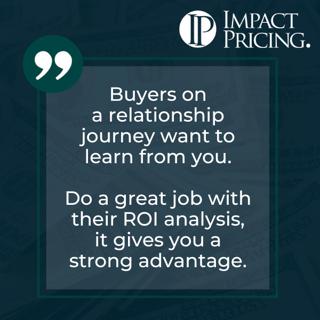
Strategic Price Increase: How to Plan, Communicate, and Succeed with Mark Peacock
Mark Peacock helps B2B Tech & Consulting firms expand margin & revenue growth with tailored pricing solutions & sales enablement. In this episode, Mark shares practical strategies for implementing price increases effectively, including a two-stage communication process to manage customer expectations and reduce resistance. He emphasizes the importance of segmenting clients by price sensitivity and value to tailor pricing strategies and build confidence. Mark also highlighted the need to treat price increases for existing customers with the same care as new business pricing to maximize business impact. Why you have to check out today’s podcast: Learn proven strategies to implement price changes confidently without losing customer trust or loyalty. Discover an innovative approach to preparing customers for price increases minimizing resistance, and maximizing acceptance. Explore techniques for segmenting clients, leveraging value-based pricing, and fostering long-term relationships. “Treat price increases for existing customers with the same importance that you do pricing for new business, because it can have such a profound impact on your business and it's nothing to be scared of.” - Mark Peacock Topics Covered: 01:48 - Describing his pricing journey 02:58 - The transformative power of smart pricing strategies 06:13 - Check out Mark's article in LinkedIn, ‘Raise Prices Without Raising Eyebrows’ 06:52 - The importance of putting as much effort into planning and communicating price increases with existing customers as devoting to winning new business 09:21 - The two-stage process to make price increase more acceptable to your customers 12:34 - The third step to communicating your price increase 14:49 - Explaining the value reasons why customers should stick with you [the fourth step] 16:55 - Communicate your 'investment story' [fifth step] 18:44 - Give your customers the options and do away with hard sell [sixth step] 21:53 - Talking about frictionless approach to price increase [seventh step] 23:22 - Important thoughts on the 'do something nice' strategy 26:45 - One top tip to help you segment customers based on price sensitivity and stop churn 27:59 - More techniques for customer segmentation 28:59 - Mark's best pricing advice Key Takeaways: “Communicating a price increase is a sales task, and you would never use negative language in a sales activity.” - Mark Peacock “The most important thing about a price increase communication is that there is no hard sell.” - Mark Peacock “You need to provide them with some ways to come back to you however they want, either to approve it, to reject it, to discuss it, or if you've got upgrade or downgrade paths as well.“ - Mark Peacock “Be as open and transparent as possible so that the buyer has total agency and control over that decision, and you are making it entirely their decision because that's how you build trust.” - Mark Peacock Connect with Mark Peacock: LinkedIn: https://www.linkedin.com/in/mark-peacock-pricemaker/ Connect with Mark Stiving: LinkedIn: https://www.linkedin.com/in/stiving/ Email: mark@impactpricing.com
27 Jan 30min

Blogcast: Perfect Pricing Is Impossible (and That’s OK)
This is an Impact Pricing Blog published on November 18, 2024, turned into an audio podcast so you can listen on the go. Read Full Article Here: https://impactpricing.com/blog/perfect-pricing-is-impossible-and-thats-ok/ If you have any feedback, definitely send it. You can reach us at mark@impactpricing.com. Now, go make an impact. Connect with Mark Stiving: Email: mark@impactpricing.com LinkedIn: https://www.linkedin.com/in/stiving/
24 Jan 4min
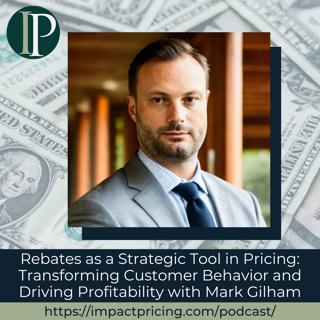
Rebates as a Strategic Tool in Pricing: Transforming Customer Behavior and Driving Profitability with Mark Gilham
Mark Gilham is an experienced senior executive with a proven track record in finance, strategy, and consulting. He brings deep expertise in driving commercial success, improving operational efficiencies, and influencing industry best practices. In this episode, Mark shares the transformative power of rebates as tools for driving both customer behavior and operational efficiency, rather than just cost-cutting mechanisms. He highlights the importance of designing rebates that align with business goals, such as incentivizing desirable customer actions, improving operational processes, and fostering long-term loyalty. Why you have to check out today’s podcast: Learn how rebates can go beyond simple cost-cutting to solve operational challenges, enhance customer loyalty, and drive profitability for your business. Gain insights into how rebates can incentivize customer behaviors that benefit both parties, creating a more collaborative and sustainable business relationship. Discover innovative ways to use rebates to optimize your operations, create efficiencies, and stronger partnerships with customers. "Get out from behind your desk; get away from the spreadsheet and understand your business. Understand what makes your business tick." - Mark Gilham Topics Covered: 01:11 - How he transitioned from accountancy to pricing 02:24 - Explaining why accountants' focus on cost-plus pricing 03:52 - Highlighting how understanding pricing enables finance professionals to interpret data more effectively and influence business outcomes 05:35 - Strategic role of rebates in B2B, their challenges, and how they differ from traditional incentives and discounts 08:18 - Importance of structuring rebates and balancing discounts and rebates in B2B to maintain margins 11:11 - Dynamics of incentivizing end consumers versus channel partners 14:59 - Optimizing rebate structures 20:40 - Sharing how rebates can incentivize operational efficiency 25:55 - Advocating for pricing teams to lead rebate strategies to create lasting customer relationships and reduce reliance on discounting 28:11 - Highlighting the potential of rebates to address operational inefficiencies Key Takeaways: "Immature pricing practices tend to be that cost-plus. And when I say immature, it's not that it's bad, it's just they don't know what good looks like or what's better." - Mark Gilham "A good rebate is a rebate that a manufacturer or supplier wants to pay out." - Mark Gilham "I believe pricing have the tools and the skillset to, and it should be on the sell side, to equip salespeople to go out, not to win an order, but to kind of win a relationship. And make that relationship sticky so that discounting actually is not, it's always going to be important, but hopefully you can take a little bit of that pressure off the table." - Mark Gilham "If you want a better deal from your supplier, think about all the things you could do to make their life easier and ask them, ‘What's that worth to you?’ And that's a far better way of getting a bit of extra money out of the contract than just saying, ‘I want my product for less.’" - Mark Gilham People/Resources Mentioned: Enable: https://www.enable.com Connect with Mark Gilham: LinkedIn: https://www.linkedin.com/in/markgilham/ Email: mark.gilham@enable.com Connect with Mark Stiving: LinkedIn: https://www.linkedin.com/in/stiving/ Email: mark@impactpricing.com
20 Jan 30min

Blogcast: You Influence Your Customers’ Willingness to Pay
This is an Impact Pricing Blog published on November 11, 2024, turned into an audio podcast so you can listen on the go. Read Full Article Here: https://impactpricing.com/blog/you-influence-your-customers-willingness-to-pay/ If you have any feedback, definitely send it. You can reach us at mark@impactpricing.com. Now, go make an impact. Connect with Mark Stiving: Email: mark@impactpricing.com LinkedIn: https://www.linkedin.com/in/stiving/
17 Jan 3min
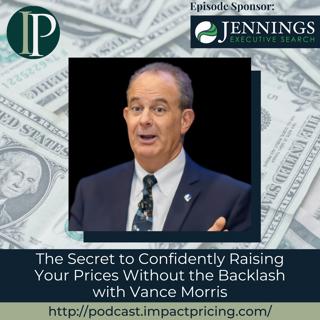
The Secret to Confidently Raising Your Prices Without the Backlash with Vance Morris
Vance Morris is a former Disney Leader turned entrepreneur, coach, speaker and author. He helps businesses deliver extraordinary customer experiences through workshops, boot camps, and training at Disney. In this episode, Vance shares practical strategies for implementing premium pricing by presenting options and building value through transparency and trust. He emphasizes the importance of creating emotional connections with customers to enhance loyalty and retention, even in B2B environments. Additionally, he advocates for confident implementation of price increases, highlighting that many pricing challenges stem from business owners' mindset rather than market resistance. Why you have to check out today’s podcast: Learn how to confidently set premium prices and create packages that differentiate your business from competitors. Discover how emotional connections, rather than just logic, can drive customer loyalty and enhance sales, even in B2B settings. Get tips on overcoming common pricing hurdles and improving customer retention through simple yet effective strategies. “People have enough information, they don't have enough implementation; just go do it. You could go out right now, raise your prices 10% and nobody's going to bat an eyelash.” - Vance Morris Topics Covered: 01:45 - How he found himself in pricing 02:31 - Sustaining a cycle of value and profitability as inspired by Disney's pricing strategies 05:20 - How he justifies premium pricing in his upholstery cleaning business 08:46 - Demonstrating expertise and showcasing value 11:32 - Emphasizing the value of positioning as a premium service rather than competing on being the second cheapest 13:00 - Maintaining pricing integrity 14:21 - Adapting Disney-inspired strategies to differentiate your business making it incomparable to competitors 16:37 - How to differentiate your products or services, even in competitive markets like B2B software 17:57 - How to foster loyalty, enhance customer retention, and make price increases more acceptable 21:09 - Highlighting the value of small, thoughtful gestures to build a positive reputation and stand out in competition 22:42 - Offering premium pricing tiers in clear, non-salesy manner 24:57 - Vance’s best pricing advice Key Takeaways: "Not so much to justify [premium pricing], as it is being able to offer a better experience, which then allows me to charge a higher price, which puts more money in my pocket." - Vance Morris "It's about creating a connection. It's people doing business with people. It's not people doing business with business and creating some kind of emotional connection with the purchasing manager, with whoever's doing the buying. And it just makes selling so much easier." - Vance Morris "When you have that connection, a price increase may not be overlooked, but is a lot more palatable than just hard excel spreadsheets flying around." - Vance Morris "There is no competitive advantage to being second cheapest; if you're not going to be the cheapest, you might as well go the other direction." - Vance Morris People/Resources Mentioned: Disney: https://www.disney.com/ Ritz-Carlton: https://www.ritzcarlton.com/ Dunkin Donuts: https://www.dunkindonuts.com/en Connect with Vance Morris: LinkedIn: https://www.linkedin.com/in/vancemorris/ Website: https://deliverservicenow.com/ Connect with Mark Stiving: LinkedIn: https://www.linkedin.com/in/stiving/ Email: mark@impactpricing.com
13 Jan 27min

Blogcast: The Fluid Nature of Willingness to Pay: How Context Shapes Your Pricing Strategy
This is an Impact Pricing Blog published on November 4, 2024, turned into an audio podcast so you can listen on the go. Read Full Article Here: https://impactpricing.com/blog/the-fluid-nature-of-willingness-to-pay-how-context-shapes-your-pricing-strategy/ If you have any feedback, definitely send it. You can reach us at mark@impactpricing.com. Now, go make an impact. Connect with Mark Stiving: Email: mark@impactpricing.com LinkedIn: https://www.linkedin.com/in/stiving/
10 Jan 4min
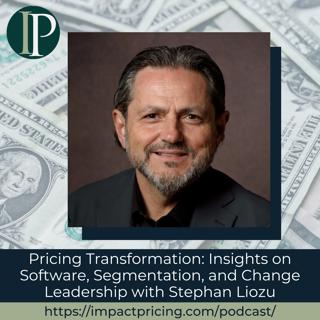
Pricing Transformation: Insights on Software, Segmentation, and Change Leadership with Stephan Liozu
Stephan Liozu is a business executive with deep knowledge in pricing strategy, value-based pricing, monetization, and transformations. He speaks the language of sales, pricing, finance, and the C-suite. In this episode, Stephan highlights the need to combine value-based pricing with strong change management for successful transformations. He shares practical segmentation strategies tailored to diverse business needs. Reflecting on his move into pricing software, he explores its potential and the challenges of gaining C-suite support. Why you have to check out today’s podcast: Delve into the nuances of value-based pricing and its implementation and practical advice for businesses aiming to maximize profitability while addressing internal and external challenges. Learn about a methodology for effective customer segmentation, practical steps, and real-world applications for targeted strategies. Discover the critical role of change management in successfully implementing pricing strategies and have a deeper understanding of organizational dynamics and leadership in pricing transformations. "You cannot do advanced pricing without advanced change management and change leadership." - Stephan Liozu Topics Covered: 01:10 - Significance of the Chief Value Officer (CVO) title 01:58 - The complexity of defining value within companies 02:52 - Contrasting his roles as a Chief Value Officer at Thales and Zilliant 04:35 - Reflecting on the challenges and uncertain future of the pricing profession with his article on LinkedIn 06:27 - Discussing the challenges of B2B pricing which hinders value-based pricing and the scalability of pricing strategies 12:11 - Advocating for internal pricing centers of excellence as cost-effective 14:01 - Explaining his approach to segmentation 17:26 - Stephan expressing excitement about his Zilliant role, exploring pricing software's potential and questioning its limited market growth 19:07 - The challenges of convincing the C-suite to invest in pricing solutions, suggesting on reframing pricing discussions under a new term 22:31 - Stephan's best pricing advice Key Takeaways: “If you want to industrialize your processes in pricing and value, you have to use an engine, the heart of this engine is software. And be able to touch all the business if possible, at least a large amount of the business.” - Stephan Liozu “Pricing professionals should become certified change managers, it should not be an option.” - Stephan Liozu People/Resources Mentioned: Thales: https://cpl.thalesgroup.com/software-monetization/software-packaging-pricing Zilliant: https://zilliant.com McKinsey: https://www.mckinsey.com Connect with Stephan Liozu: LinkedIn: https://www.linkedin.com/in/stephanliozu/ Website: https://www.stephanliozu.com/ Connect with Mark Stiving: LinkedIn: https://www.linkedin.com/in/stiving/ Email: mark@impactpricing.com
6 Jan 23min
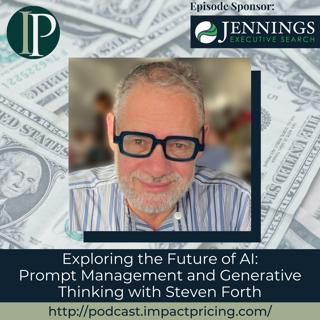
Exploring the Future of AI: Prompt Management and Generative Thinking with Steven Forth
Steven Forth is Ibbaka’s Co-Founder, CEO, and Partner. Ibbaka is a strategic pricing advisory firm. In this episode, Steven discusses how AI, particularly transformer models, is revolutionizing business strategies by automating complex tasks like value modeling and scenario planning, making them more efficient. He emphasizes the importance of leveraging AI to explore frameworks and generate innovative solutions, such as using AI to better understand industry problems. Steven also highlights the ongoing development of prompt orchestration tools, which will soon become essential for managing AI workflows and optimizing the use of multiple models. Why you have to check out today’s podcast: Discover how AI is transforming traditional frameworks like value modeling, scenario planning, and pricing, making complex processes faster and more efficient. Gain insights on how AI can help you better understand problems and create innovative solutions, ultimately improving your decision-making process. Dive into emerging concepts like prompt orchestration and how AI is evolving, giving you the tools to enhance your AI workflows for maximum effectiveness. “Create a series of prompts, create a series of context documents that you can reuse and explore the framework in ways that you never could before and find ways of applying it.” - Steven Forth Topics Covered: 02:10 - How no single AI model can meet all needs, thus, advocating for multiple model for diverse perspectives and specialized capabilities 03:11 - Distinguishing between diffusion models and transformer models 05:46 - How does a transformer model work 07:28 - Understanding the [LQMs] Large Quantitative Models, [RAG] Retrieval Augmented Generation and challenges faced by companies like Pros in leveraging customer-owned data 11:39 - How Wolfram/Alpha uses mathematical reasoning to validate and simplify equations and highlighting the emergence of reasoning models for complex problem-solving 15:34 - Steven reflecting on his increasing reliance on AI tools, how they are transforming his thinking, and the need to embrace these technologies as vital partners in enhancing exploration, communication, and decision-making 17:17 - How generative AI enables more dynamic and efficient approaches to scenario planning 23:29 - Emphasizing how leveraging AI with established frameworks accelerates complex tasks like building value models 25:13 - Learning 'prompt orchestration’ to optimize prompt sequences and responses 26:52 - Explaining Perplexity's limitations in generating complete outputs Key Takeaways: “It used to take Ibbaka between 40 and 60 hours of work by a highly trained person to build a value model. It now takes us less than two hours to build a better value model than we could have done before.” - Steven Forth People / Resources Mentioned: Geoffrey Hinton: https://en.wikipedia.org/wiki/Geoffrey_Hinton Bloomberg: https://www.bloomberg.com/asia Attention is All You Need paper: https://en.wikipedia.org/wiki/Attention_Is_All_You_Need Sam Altman: https://en.wikipedia.org/wiki/Sam_Altman Karen Chiang: https://impactpricing.com/podcast/467-minimize-churn-and-boost-your-net-dollar-retention-with-karen-chiang/ Porter's 5 Forces: https://en.wikipedia.org/wiki/Porter%27s_five_forces_analysis Clayton Christensen: https://en.wikipedia.org/wiki/Clayton_Christensen William Gibson: https://en.wikipedia.org/wiki/William_Gibson Perplexity AI: https://www.perplexity.ai ChatGPT: https://chatgpt.com You.com: https://you.com Hugging Face: https://huggingface.co Connect with Steven Forth: LinkedIn: https://www.linkedin.com/in/stevenforth/ Email: steven@ibbaka.com Connect with Mark Stiving: LinkedIn: https://www.linkedin.com/in/stiving/ Email: mark@impactpricing.com
30 Dec 202430min
